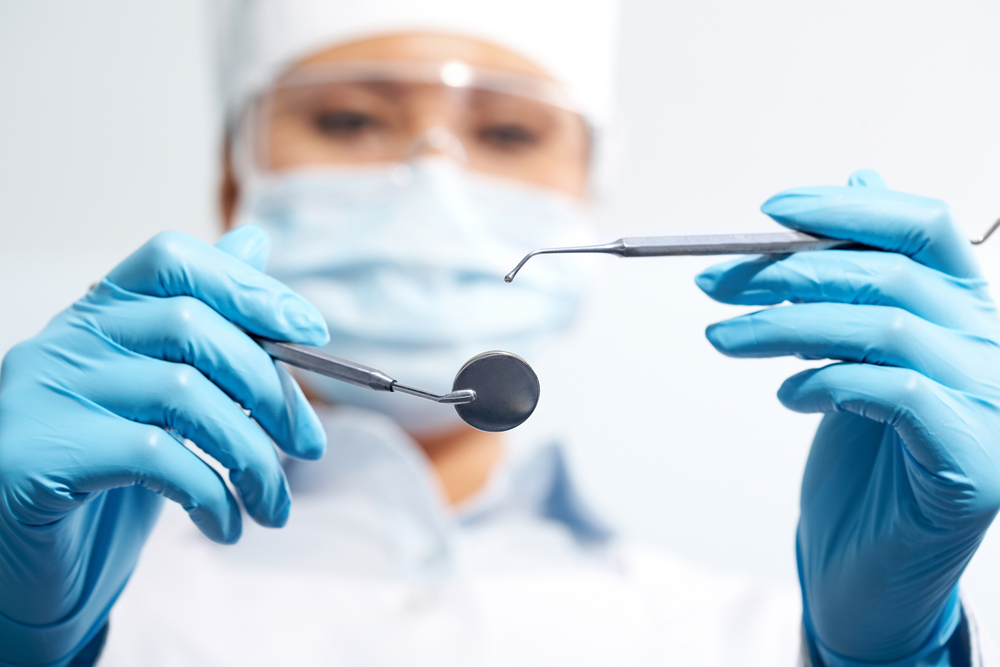
It can be alarming when you notice a bump on your gums, especially if it’s painful. While any time you experience changes in the soft tissues of your mouth or have oral pain, you should visit your dentist, not every bump is a sign of a serious issue. In this post, we’ll cover the causes and what to do to get relief.
Why Is There a Bump on My Gums?
Here are a few common reasons why you might have a bump:
- An Abscess – An extremely sensitive, painful bump on your gums that looks like a pimple is likely an abscess. An abscess is due to a bacterial infection and occurs as pus collects under the gum, forming a bump or boil.
There are different types of abscesses, including a periodontal abscess, which is usually caused by periodontitis (advanced gum disease), and a periapical abscess, which is an infection at the tip of your tooth’s root from tooth decay or an injury. A periapical abscess usually presents as a bump on the gums above or below the affected tooth.
If you do have an abscess, it will often be accompanied by other symptoms including:
- Swollen gums
- Bad breath
- Sensitivity to hot and cold
- Fever
- Discharge
- Fatigue
- Facial swelling
- Persistent pain that may spread to the ear, jaw and neck
It’s important to have an abscess evaluated and treated. It won’t go away on its own. While it can drain and provide temporary relief, the infection will still be present and can spread to the jaw and supporting tissues. In rare cases, a dental infection can reach the brain and cause serious health complications.
Treatment for an abscess will involve treating the infection, whether through periodontal care or a root canal, and, sometimes, antibiotics. We might also drain the abscess to give you immediate relief.
- A Canker Sore – We’ve had patients at our Naperville dental practice visit worried they had an abscess and it turned out they had a canker sore, or aphthous ulcer. Even though canker sores are benign and don’t cause serious issues, they can be extremely painful.
A canker sore usually looks like a flattish, yellow or white bump or blister on the gums surrounded by a red border. The sores can appear in a cluster and they make talking and eating difficult.
Canker sores are not contagious and no one knows exactly what causes them, though it’s thought that the following can play a role:
- Stress
- Vitamin deficiencies
- Food allergies
- Genetics
- illness
- Mouth injuries
- Certain medications
The mouth ulcers don’t usually require treatment and tend to resolve on their own within two weeks.
- Cyst – A cyst will look like a small, liquid-filled bubble, or bump, on the gums. Dental cysts tend to pop up around the root of diseased, malpositioned or impacted teeth. Many times, cysts are painless. However, they can grow larger and put pressure on the teeth and jaw or become infected, both of which will cause pain.
While you should have a cyst looked at by your Naperville general dentist, whether it requires treatment or not will depend on its cause and size. Most cysts resolve on their own, however, some need to be removed surgically.
- Oral Fibroma – An oral fibroma appears as a smooth, hard bump on the gums. A fibroma is a tumor-like mass of connective tissue that’s almost always benign. Fibromas develop when an area of the mouth is constantly irritated or traumatized, such as from a habit like biting the inside of your cheek or from ill-fitting dentures or another oral appliance.
Treatment will depend on the size, location, type and cause of the fibroma. You may need to have your dentures or oral appliance re-fitted so that it stops irritating your mouth.
Though fibromas aren’t usually painful, if they get larger, they can become easily irritated, leading to discomfort. In those cases, surgical removal could be recommended.
- Bony Growth – A bony, round, hard bump on the gums is known as a dental torus (or tori plural). It’s a bony protrusion that grows on top of existing bone. The bumps are usually smooth and covered completely in gum tissue.
The different types of dental tori are classified by their location. For example, a torus mandibularis is located on the inside of the lower jaw on the side nearest the tongue. A torus palatinus is a protrusion from the roof of the mouth, or palate.
Dental tori don’t usually interfere with function or cause pain. Rarely, a tori will continue growing and become irritated or get in the way of dentures. In these cases, it may need to be removed.
There isn’t a known cause of bony growths on the gums but some experts think bruxism, genetic factors, diet and/or stress on the jaw from a bad bite may be the cause.
- Oral Cancer – While most bumps are benign, occasionally, a small growth or lump on the gum tissue is a sign of oral cancer. It might be accompanied by other symptoms, such as:
- A red or white patch on your gums
- Thickening of the skin
- A sore that bleeds and/or won’t heal
- Jaw or tongue pain
- Loose teeth
- Sore throat
- Difficulty chewing or swallowing
Risk factors for oral cancer include:
- A family history of oral cancer
- Heavy drinking
- Tobacco use
- Having human papillomavirus (HPV)
- Being over age 40
- Having a weakened immune system
- A lack of fruit and vegetables in the diet
At Naperville Dental Specialists, we offer VELscope oral cancer screenings. VELscope is a small, handheld tool that uses light to painlessly identify pre-cancerous and cancerous lesions.
When caught early, oral cancer has a high survival rate. If you’re worried a lump is cancerous, schedule a visit at Naperville Dental Specialists. It’s also good practice to have a screening as part of your routine dental exams.
Can I Pop a Bump on My Gums?
No. You should never pop a bump on your gums. Even popping a harmless bump will cause irritation and pain, making the situation worse.
Though an abscess will sometimes drain on its own, popping it can damage the soft tissue and it will release bacteria into your mouth. If an abscess does drain on its own, gently swish with a saltwater rinse to get rid of the foul-tasting liquid and keep your mouth clean.
How to Get Rid Of Bumps on Gums
Unfortunately, there is nothing you can do to get rid of bumps on your gums at home, in most cases. You should see your dentist for treatment if the bump doesn’t go away after a few weeks or it is accompanied by the signs of an abscess or oral cancer we noted above.
While you’re waiting to see your dentist, you can alleviate pain by:
- Swishing with a saltwater rinse (½ teaspoon of salt dissolved in a glass of warm water)
- Avoiding irritating the bump when brushing or flossing or wearing an appliance
- Taking an over-the-counter pain reliever as needed
- Sticking with a soft foods diet
To prevent painful bumps on your gums in the future:
- Practice good oral hygiene
- Break repetitive habits that cause oral irritation like biting the inside of your cheek or grinding your teeth
- Maintain a well-rounded, healthy diet
- Manage stress
- Avoid heavy drinking and using tobacco products
- Keep up with regular dental exams and cleanings
Schedule a Visit with a Naperville General Dentist
If a bump on your gums is bothering you or causing you to worry, schedule a visit with a general dentist at Naperville Dental Specialists today. We use high-tech diagnostic tools, so we can determine what’s causing the bump and create a personalized treatment plan to help you find relief.











 Common Cosmetic Dental Procedures
Common Cosmetic Dental Procedures
 How to Protect Your Teeth From Apple Cider Vinegar
How to Protect Your Teeth From Apple Cider Vinegar


































